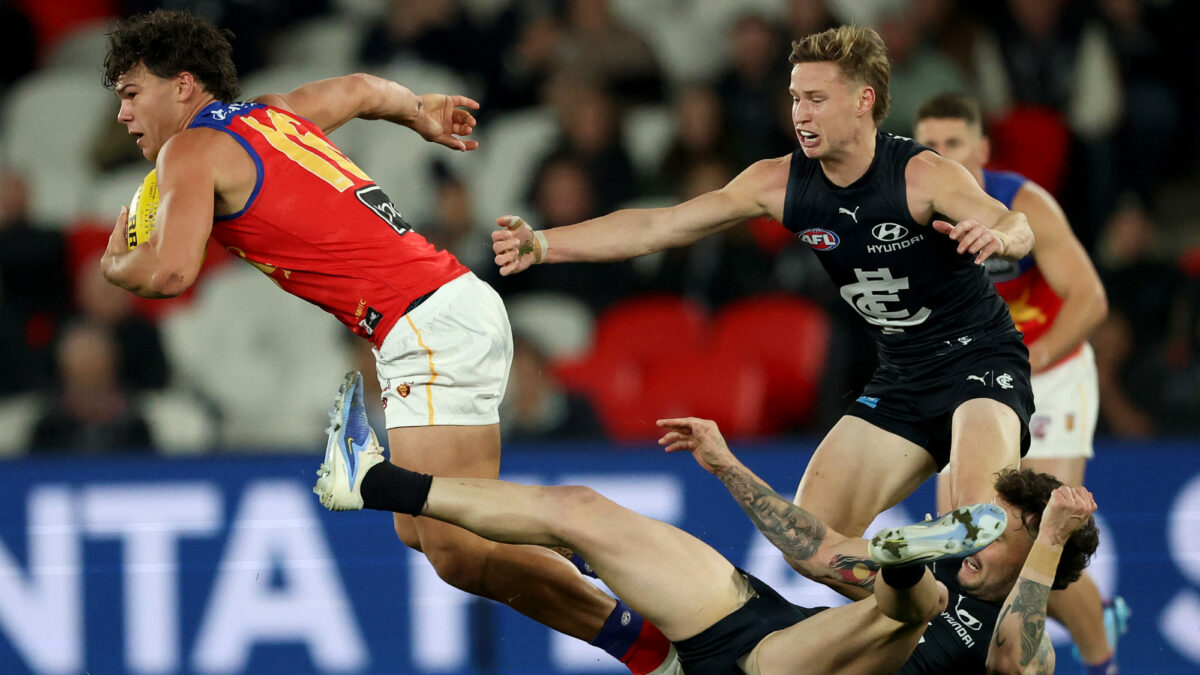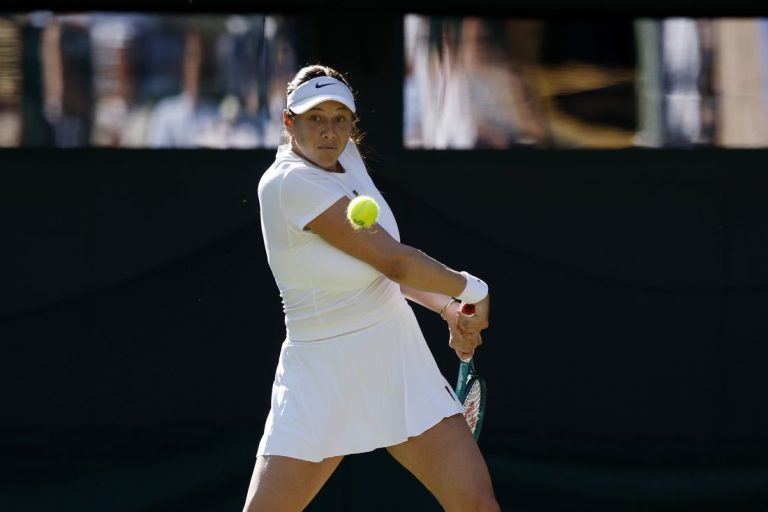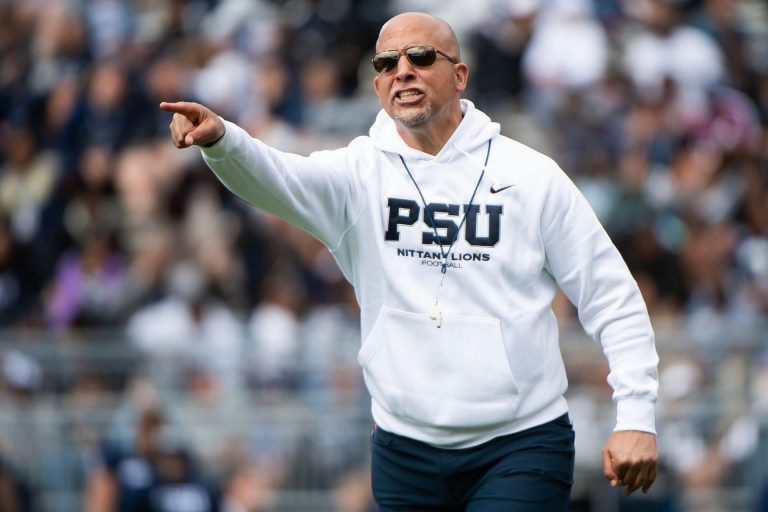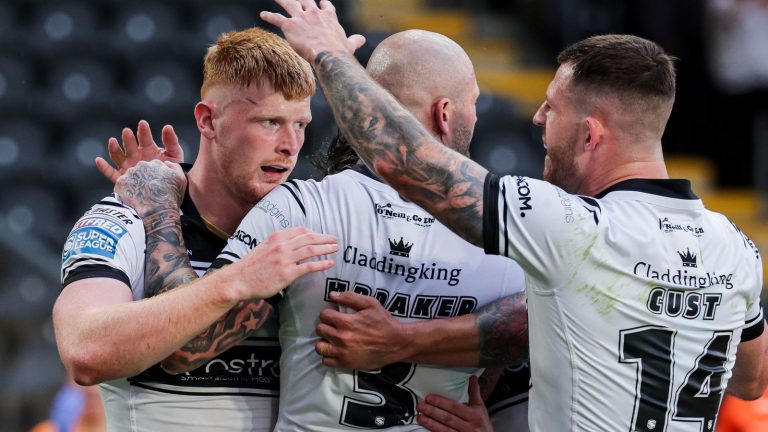On Thursday night at Marvel Stadium, Carlton played their best game in more than two months.
They tackled with desperation. They got their hands dirty at the coalface. Patrick Cripps looked every inch the stoppage beast he was in his record-breaking Brownlow Medal-winning season last year, while Charlie Curnow worked himself to exhaustion up and down the wing and showcased tremendous marking strength.
And yet, they didn’t have a hope in hell of beating Brisbane.
They didn’t even get close.
Enough has been said about the Blues’ struggles in recent weeks, so it’s only right to acknowledge that their 37-point loss had little if anything to do with their own performance. They were brutalised by a premiership contender playing at maximum output – and maybe picking up a few extra strings to add to an already overflowing bow.
Best of all for Chris Fagan, a goalless last quarter in which the Lions fell into several familiar bad habits, most obviously inaccuracy in front of goal but also more than a hint of lairising in trying for the impossible, gives him plenty of excuse to demand more from his troops in the weeks to come, and prevent them from again stagnating as they have on occasion in this premiership defence to date.
But 52 points to the good at three-quarter time was a statement of intent from the reigning premiers, no matter the quality or the ladder position of their opponents.
This game was played on Brisbane’s terms from the outset: the Blues gave it their all, especially in tight, but were simply powerless to stop the Lions’ sharp hands and pinpoint kicking skills to spread from stoppages and use the wide expanses of Marvel Stadium in a matter of seconds.
The highest marking team in the AFL had 130 of them by match’s end, all but ten uncontested, and only partially swelled by the typical late junk time kick-around.
What’s most impressive about the Lions is that they are by no means a fast-moving team, and yet they keep the football perpetually shifting into dangerous positions. A mark at half-back invariably leads to either a slicing kick from a Dayne Zorko, Darcy Wilmot or Jaspa Fletcher to a free teammate in the corridor, or starts a dangerous sideways switch to the other wing and forcing their opposition to cover the full width of the ground to defend them again.
Their failsafe is what most other teams would have as their first option: a short, 15-metre pass down the line to a leading teammate; again, an option that leaves them better placed than from the previous disposal.
The Lions’ most underrated asset, furthermore, is the core strength of their key midfield players; it’s impossible to count how many tackles Cam Rayner, Lachie Neale, Zac Bailey and co. shrug in order to get themselves into space, but what is noticeable is that that’s universally their first option when winning the ball in close.
It takes confidence as well as skill to play in this manner; but Carlton’s on-ballers just weren’t able to cope with it.
The result is maximum efficiency from their clearance wins, getting the ball deep and dangerous to their wide array of goalkicking options: the Blues soundly won the clearance count 37-29 – no mean feat against the best stoppage team in the AFL this year – but lost centre clearances 10-12, and gave up 16 more inside 50s. You just can’t beat Brisbane with a stat line like that.
Early days, it was the Blues’ control from clearances, led by a monster first half from Cripps, that kept them in the hunt – but the Lions had a plan for that too.
Fully aware of the Blues’ tendency to aimlessly bomb inside 50 under pressure, the Lions upped their usual ante, demonstrating a ferocity they probably haven’t exhibited since last year’s grand final masterclass: their 44 tackles at half time are their most at the same stage for the entire season. That number tapered off to ‘only’ 69 by the end, but it was still 11 more than Carlton managed, while finishing with 38 more disposals.
Josh Dunkley, the inaugural Robert Walls Medallist, embodied their approach with 13 tackles, three of them holding the ball free kicks – and only Eric Hipwood and sub Darcy Gardiner didn’t finish with at least one tackle to their name.
It was at its fiercest inside attacking 50, where the Lions, unable to rule the skies with Hipwood quiet and the Blues matching them aerially, set to work at ground level to hand the Carlton smalls a ferocious working over.
Matt Carroll will have nightmares all weekend after twice being caught holding the ball in a matter of minutes, erroneously thinking he had a second’s worth of time and space that, in Brisbane’s forward 50 on Thursday night, was harder to find than a Blues supporter who doesn’t think Sam Docherty’s time is up.
20 tackles inside 50 was the reward – and it honestly felt like double that amount.
What should be alarming for every other team in the finals race is that this isn’t a characteristic you usually associate with Brisbane. This year, they are the second-lowest tackling team in the AFL, and while that number jumps to equal-sixth in the league for tackles inside 50, their average per game is 11 – a mark they hit two minutes into the third quarter.
That that emphasis on pressure manifested in Charlie Cameron’s best game in some time, with three goals and the menace of his heyday, as well as impressive contributions from young guns Kai Lohmann and Logan Morris (four and two tackles inside 50 respectively) without needing to exclusively hit the scoreboard, is a worrying new development considering they headed into the season as the team to beat.
If that can be combined with a more complete stoppages game – you’d think that’s a given considering it’s the Blues’ one wood while few other sides can boast a Cripps in raging bull mode – and their typically devastating slingshot running from half-back whenever given a chance to burst forward at high speed, then perhaps not even Collingwood’s beautifully structured defensive set-up can cope with what the Lions can throw at them.
Brisbane were already terrifying. They might just have got scarier still.
The Blues, quite frankly, didn’t have a prayer.





